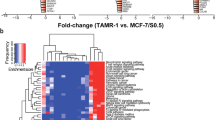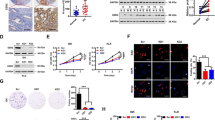Abstract
Estrogen receptor (ER)-negative breast cancer cells display extensive methylation of the ER gene CpG island and elevated DNA methyltransferase (DMT) expression compared to ER-positive cells. The present study demonstrates that DMT protein levels tightly correlate with S phase fraction in ER-positive cells, whereas ER-negative cells express DMT throughout the cell cycle. In addition, levels of p21CIP1, which disrupts DMT binding to PCNA, are inversely correlated with DMT levels. Therefore increased DMT expression in ER-negative cells is not simply due to elevated S-phase fraction, but rather to more complex changes that allow cells to escape normal cell cycle-dependent controls on DMT expression. Because ER-negative breast tumors often have activated growth factor pathways, the impact of these pathways on DMT expression was examined in ER-positive cells. Stable transfection with fibroblast growth factors (FGFs) 1 and 4 led to increased DMT expression that could not be accounted for by a shift in S phase fraction. Elevated DMT protein expression in FGF-transfectants was accompanied by a significant decrease in p21, again suggesting a reciprocal relationship between these two proteins. However, acquisition of an estrogen-independent phenotype, even in conjunction with elevated DMT levels, was not sufficient to promote ER gene silencing via methylation. These results indicate that multiple steps are required for de novo methylation of the ER CpG island.
This is a preview of subscription content, access via your institution
Access options
Subscribe to this journal
Receive 50 print issues and online access
$259.00 per year
only $5.18 per issue
Buy this article
- Purchase on Springer Link
- Instant access to full article PDF
Prices may be subject to local taxes which are calculated during checkout








Similar content being viewed by others
References
Araujo FD, Knob JD, Szyf M, Price GB and Zannis-Hadjopoulos M. . 1998 Mol. Cell. Biol. 18: 3475–3482.
Bakin AV and Curran T. . 1999 Science 283: 387–390.
Belinsky SA, Nikula KJ, Baylin SB and Issa J-PJ. . 1996 Proc. Natl. Acad. Sci. USA 93: 4045–4050.
Bird AP. . 1986 Nature 321: 209–213.
Chuang LSH, Ian H-I, Koh T-W, Ng H-H, Xu G and Li BFL. . 1997 Science 277: 1996–2000.
Clarke R, Skaar T, Baumann K, Leonessa F, James M, Lippman J, Thompson EW, Freter C and Brunner N. . 1994 Breast Cancer Res. and Treat. 31: 237–248.
Counts JL and Goodman JI. . 1995 Cell 83: 13–15.
Dickson RB and Lippman ME. . 1995 Endocrine Rev. 16: 559.
Early Breast Cancer Trialists Collaborative Group. . 1998 The Lancet 351: 1451–1467.
El-Ashry D, Miller DL, Kharbanda S, Lippman ME and Kern FG. . 1997 Oncogene 15: 423–435.
Ferguson AT, Vertino PM, Spitzner JR, Baylin SB, Muller MT and Davidson NE. . 1997 J. Biol. Chem. 3272: 32260–32266.
Ferguson AT, Lapidus RG, Baylin SB and Davidson NE. . 1995 Cancer Res. 55: 2279–2283.
Filmus J, Pollak MN, Carlleau R and Buick RN. . 1985 Biochem. Biophys. Res. Commun. 128: 898–905.
Kass SU, Pruss D and Wolffe AP. . 1997 TIG 13: 444–449.
Kern FG, McLeskey SW, Zhang L, Kurebayashi J, Liu Y, Ding IYF, Kharbanda S, Chen D, Miller D, Cullen K, Paik S and Dickson RB. . 1994 Breast Cancer Res. and Treat. 31: 153–165.
Kraus MH, Yuasa Y and Aaronson SA. . 1984 Proc. Natl. Acad. Sci. USA 81: 5384–5388.
Laird PW and Jaenisch R. . 1996 Annu. Rev. Genet. 30: 441–464.
Lapidus RG, Ferguson AT, Ottaviano YL, Parl FF, Smith HS, Weitzman SA, Baylin SB, Issa J-PJ and Davidson NE. . 1996 Clinical Cancer Res. 2: 805–810.
Lapidus RG, Nass SJ and Davidson NE. . 1998a J. Mammary Gland Biol. Neoplasia 3: 85–94.
Lapidus RG, Nass SJ, Butash KA, Parl FF, Weitzman SA, Graff JG, Herman JG and Davidson NE. . 1998b Cancer Res. 58: 2515–2519.
Lee PJ, Washer LL, Law DJ, Boland CR, Horon IL and Feinberg AP. . 1996 Proc. Natl. Acad. Sci. USA 93: 10366–10370.
MacLeod AR, Rouleau J and Szyf M. . 1995 J. Biol. Chem. 270: 11327–11337.
Maki CG and Howley PM. . 1997 Mol. Cell. Biol. 17: 355–363.
McGuire WL. . 1978 Seminar Oncol. 5: 428–433.
Miyoshi E, Jain SK, Sugiyama T, Fujii J, Hayashi N, Fusamoto H, Kamada T and Taniguchi N. . 1993 Carcinogenesis 14: 603–605.
Ottaviano YL, Issa J-P, Parl FF, Smith HS, Baylin SB and Davidson NE. . 1994 Cancer Res. 54: 2552–2555.
Rouleau J, MacLeod AR and Szyf M. . 1995 J. Biol. Chem. 270: 1595–1601.
Samaan NA, Buzdar AV, Aldinger KA, Schultz PN, Yang K, Romsdahl MM and Martin R. . 1981 Cancer 47: 554–560.
Szyf M, Bozovic V and Tanigawa G. . 1991 J. Biol. Chem. 266: 10027–10030.
Szyf M, Kaplan F, Mann V, Giloh H, Kear E and Razin A. . 1985 J. Biol. Chem. 260: 8653–8656.
Vertino PM, Yen RC, Gao J and Baylin SB. . 1996 Mol. Cell. Biol. 16: 4555–4565.
Vickers PJ, Dickson RB, Shoemaker R and Cowan KH. . 1988 Mol. Endocrinol. 2: 866–892.
Vindelov LL, Christensen IJ and Nissen NI. . 1983 Cytometry 3: 323–327.
Wu J, Issa JP, Herman J, Bassett DE, Nelkin BD and Baylin SB. . 1993 Proc. Natl. Acad. Sci. USA 90: 8891–8895.
Acknowledgements
We are grateful to Ravi Veeraswami and Xiaohui Lin for preparing and characterizing the DMT antibody. We also thank Robert Clarke of the Lombardi Cancer Center and Francis Kern from Southern Research Institute for generously providing the cell lines used in this study. The DMT antisense expression vector was generously provided by Paula Vertino at the Emory University School of Medicine. Finally, we are grateful to Jim Fluke of the Johns Hopkins Oncology Center Flow Cytometry Facility for performing the FACS analysis. This work was supported by grants from the American Cancer Society (NE Davidson, AT Ferguson), Susan G Komen Foundation (NE Davidson), the National Cancer Institute (NE Davidson, SJ Nass), and the United States Army Research and Materiel Command (SJ Nass). In addition, an AFLAC Travel Fellowship to SJ Nass made it possible to present part of this work at the 90th Annual Meeting of the American Association for Cancer Research.
Author information
Authors and Affiliations
Rights and permissions
About this article
Cite this article
Nass, S., Ferguson, A., El-Ashry, D. et al. Expression of DNA methyl-transferase (DMT) and the cell cycle in human breast cancer cells. Oncogene 18, 7453–7461 (1999). https://doi.org/10.1038/sj.onc.1203138
Received:
Revised:
Accepted:
Published:
Issue Date:
DOI: https://doi.org/10.1038/sj.onc.1203138
Keywords
This article is cited by
-
Spontaneously immortalised bovine mammary epithelial cells exhibit a distinct gene expression pattern from the breast cancer cells
BMC Cell Biology (2010)
-
DNA Methylation and Demethylation as Targets for Anticancer Therapy
Biochemistry (Moscow) (2005)
-
DNA methylation, imprinting and cancer
European Journal of Human Genetics (2002)
-
DNA methylation, chromatin inheritance, and cancer
Oncogene (2001)



